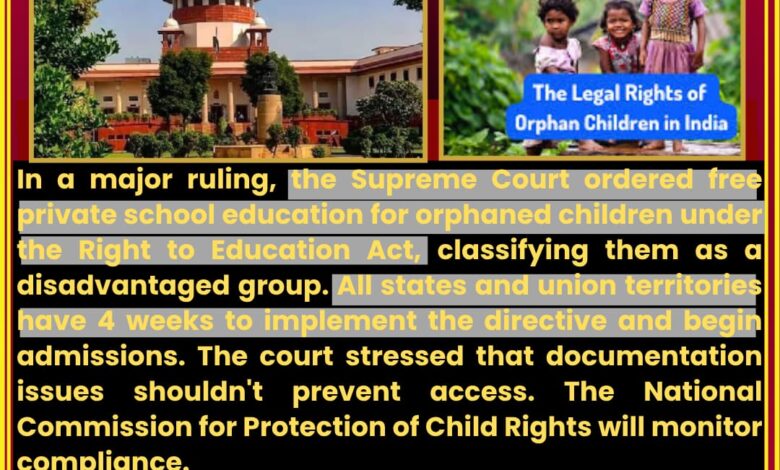
New Delhi, August 6, 2025
In a landmark judgment aimed at supporting the nation’s most vulnerable children, the Supreme Court of India on Tuesday, August 5, directed all states and union territories to provide free private school education to orphaned children under the Right to Education (RTE) Act, 2009.
The apex court has given governments across India four weeks to submit a compliance report and begin implementation. The order emphasizes the constitutional right to education and the state’s responsibility towards children who have lost parental support.
⚖️ Court’s Directive: Protection of Orphaned Children
A bench led by Chief Justice D.Y. Chandrachud observed that orphaned children fall under the “disadvantaged group” defined in the RTE Act. The court ruled that these children are entitled to admission in private unaided schools under the 25% reservation mandate for economically and socially disadvantaged children.
“The State has a constitutional obligation to ensure that orphaned children do not fall through the cracks of the education system,” stated the bench in its order.
📚 RTE Act: Ensuring Equitable Education
Under the Right to Education Act, all private unaided schools must reserve 25% of their entry-level seats for children from weaker and disadvantaged sections. While this provision has been implemented in parts, orphans were often excluded due to documentation and lack of clarity.
The Supreme Court clarified that lack of guardianship or documentation cannot be used to deny admission, and state governments must create special identification mechanisms to bring such children into the education system.
🕒 Four-Week Deadline for All States and UTs
The court has directed chief secretaries of all states and union territories to:
-
Identify orphaned children through child welfare and juvenile justice departments
-
Ensure admission in private schools under RTE
-
Submit a compliance report within four weeks
The judgment comes after several petitions were filed pointing to the exclusion of orphans from RTE benefits in many parts of the country.
📍 Focus on Implementation & Monitoring
The court also urged the Ministry of Education and State Education Departments to monitor the effective implementation of the directive. The National Commission for Protection of Child Rights (NCPCR) has been asked to oversee compliance and report any lapses.
States have also been directed to publicize the scheme, so that eligible children and caretakers can approach schools without facing administrative hurdles.
🧒 India’s Orphaned Children: The Need for Protection
India is home to over 2.5 crore orphaned or abandoned children, according to estimates from child welfare agencies. A large number of them live in institutional homes or with distant relatives and often struggle to access formal education, especially in urban centers.
This Supreme Court ruling is seen as a major step toward inclusive education, potentially impacting lakhs of children nationwide who have been left out of private school access due to systemic gaps.
📊 Key Highlights of the SC Order
| Directive | Details |
|---|---|
| Judgment Date | August 6, 2025 |
| Bench Headed By | CJI D.Y. Chandrachud |
| Provision Used | Right to Education Act, 2009 – 25% Reservation Rule |
| Target Beneficiaries | Orphaned children across India |
| Implementation Timeline | 4 weeks for all states and UTs |
| School Types Covered | Private unaided schools |
| Oversight Body | NCPCR & State Education Departments |
🗣️ Public Reaction and Expert Opinions
Education experts and child rights activists welcomed the verdict, calling it a “historic victory” for child protection in India.
“This will bridge a huge access gap and bring dignity and opportunity to children who otherwise had no voice,” said a child welfare NGO director.










